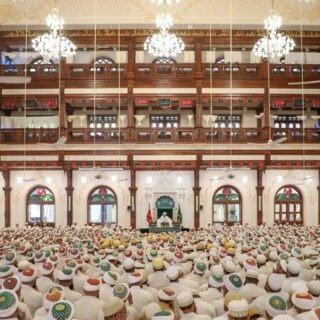Overview
The Chandabhoy Galla Case is the most celebrated case in the history of dawat. The case was filed by the Advocate General of Mumbai at the behest of Adamjee Pirbhai family members. The case was filed in 1917 and decided in 1921. The case related to a number of properties including a) the tomb of Seth Chandabhoy Currimbhoy and the offerings placed in the galla; b) Badri Mahal which was then the residence of Syedna Taher Saifuddin (RA). Issues raised, however, were of far greater significance than the properties included in the case.
Enemies’ objects in filing the case:
What were the aims of the enemies? They were asking the High Court, being the highest court in the Province of Mumbai to decide and hold that: 1) Syedna Taher Saifuddin (RA) was not the Dai al Mutlaq. 2) Syedna (RA) had no right on any community properties. 3) Syedna (RA) should be removed as a trustee of dawat properties, and function as the court appointed trustee.
Issue of Nass on Syedna Najmuddin Saheb (RA):
It was contended that Syedna Najmuddin Saheb (RA) was not validly appointed as Dai al Mutlaq. If this contention was upheld by the court, then the position of all subsequent Dai al Mutlaqs would be put into question. Syedna Taher Saifuddin’s (RA) claim to be the Dai al Mutlaq was dependant upon the court deciding that Syedna Najmuddin (RA) was validly appointed. Dawat’s enemies produced forged letters and records to support their claim that nass had not been performed on Syedna Najmuddin (RA); however the High Court rejected these and accepted as true, evidence produced by Syedna (RA).
Significance of the court’s verdict on the issue of nass:
What would have been the consequence if the Mumbai High Court had decided in favor of dawat’s enemies? It would have meant that in the eye of the law Syedna Najmuddin (RA) was not validly appointed and, consequently, Syedna Taher Saifuddin (RA) was not Dai al Mutlaq. So far as mumineen are concerned, it would have made no difference in their belief and faith. However, from a legal perspective the mission of dawat would have ended after the 46th Dai. The law of the land would be completely at odds with the fundamental tenet of our faith: the tasalsul of Duat Mutlaqeen (AS).
Issue of community properties:
According to the court there were two positions that Syedna could hold: either he was the trustee, or the owner. Syedna (RA) claimed that he was neither the trustee nor the owner: the maalik, the owner, was Imam uz zaman; and he would not call himself a trustee who could be held accountable to the people. Syedna (RA) declared that he was a trustee appointed by Imam uz zamaan, and answerable only to the Imam. The court ruled in favor of Syedna (RA). It held that Syedna (RA) was the sole trustee of community properties and had the exclusive right to manage and control them.
Significance of the verdict on community properties:
Imagine a hypothetical scenario where the Dai al Mutlaq does not have any right or interest in ownership and management of community properties which include mosques, schools, jamaatkhanas etc. Control of these would have stood vested in government appointed, “mutawalis”. It is difficult to think of a greater disaster.
Syedna’s (RA) hearing:
It took 16 days to record Syedna Saifuddin Saheb’s (RA) evidence. There were over 1450 questions asked in examination and cross examinations. Syedna’s (RA) testimony would rank as the most brilliant and lengthy in the history of legal proceedings in the Sub-continent. In deference to Syedna’s (RA) exalted position evidence was recorded at the residence of Justice A.B. Martin and not in court. One of the highlights of the hearing was when the Advocate General challenged Syedna (RA): he asked Syedna (RA) if “Imam” who he quoted so often was referred to in the Quran. Instantaneously, Syedna (RA) recited the ayat sharifa,
We have recorded all things in the Imam e mubin.
The English translation that the judge had with him, read: “We have recorded all things in clear writing”. The Muslim attorney, however, confirmed that the word “Imam” was indeed present in the original Arabic text.
Fate of Adamjee Pirbhai family:
1) Adamjee Pirbhai family lost their wealth. 2) Pirbhai family’s Malabar Hill mansion in Mumbai was bought by Syedna Taher Saifuddin (RA) and became Saify Mahal. It will be difficult to find a better example of angelic irony and poetic justice.
Excerpts from “Overview of Judicial and Legislative Triumphs” by Abdulhusen M. Haidermota








